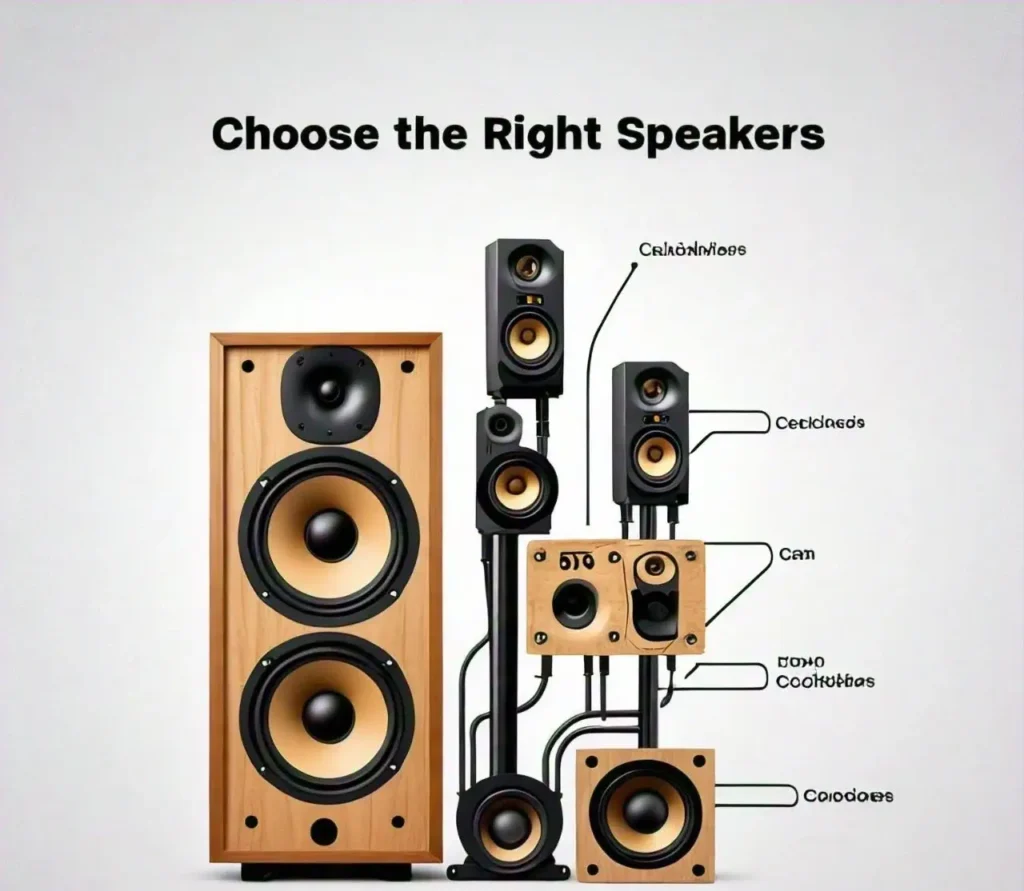If you want clean, better, and immersive sound at home? You don’t need to replace the whole audio setup. With some expert tips, you will get better results from your current system and enjoy a unique or great listening experience.
Look at the 8 expert tips presented here to Enhance Your Home Audio System.

1. Choose the Right Speakers
Speakers are the base of a sound system. The quality and type of speaker you choose can significantly affect sound quality. Here are some factors to consider:
Speakers Type: Floorstanding speakers offer powerful sound and bass, while bookshelf speakers are compact and versatile. For a balanced setup, consider a mix of both.
Speakers sensitivity: Highly sensitive speakers (above 90dB) require less power to produce sound, which makes them ideal for smaller rooms.
Frequency Response: You must look at a speaker with a wide frequency range to ensure that it accurately reproduces both the lowest bass and highest treble sound.
2. Invest in a Quality Amplifier
An amplifier can greatly impact your speaker sound quality and drive your speakers. When you are choosing an amplifier you must notice some features which are presented here:
Power Output: Ensure that your amplifier fills the power needs of your speakers. Check the power range recommended for speakers and match it with the amplifier output.
Signal-to-Noise Ratio (SNR): A high SNR means less background noise which translate the clear sound.
Connectivity: Look for an amplifier with multiple inputs and outputs to accommodate all your audio sources and future expansions.
3. Optimize Speaker Placement
Proper speaker placement can dramatically improve sound quality. Follow these guidelines:
Room Acoustics: You must think about your room acoustics. A hard surface reflects sound, otherwise, a soft surface was observed it. Use furniture, carpets, and rugs to balance the room’s acoustics.
Speaker Position: Place your speakers at ear level and angle toward the listening area. For floor-standing speakers, place them at least a few inches away from the walls to reduce the bass distortion.
Stereo Imaging: You must ensure the distance is equal between the left and right speakers and your listening position to create a balanced stereo image.
4. Use Quality Cables
A best-quality cable will affect the sound quality of your system. Here’s what to consider:
Speaker Cables: Choose low-resistance cables for minimal signal loss. Mostly thicker cables (lower gauge number) are better for longer runs.
Interconnect Cables: You must use shielded cables to prevent interference and maintain the signal integrity.
HDMI and Optical Cables: For digital connection, you must use high-quality HDMI and optical cables to ensure clear, lossless transmission.
5. Calibrate Your System
For the most incredible sound, you must calibrate your speakers. It removes room wideness and makes music according to your space. It made every listening section a masterpiece.
Magic Microphone: Some receivers include software or a microphone that works like a hearing aid for the speakers. You place the microphone usually you sit and just follow the instructions of the software. After it will adjust speakers for a perfect sound for your room.
Tweaking the Tunes: After the microphone does its work, you will make small adjustments to your speaker volume, how the bass blends with the higher notes, and any sound delays to match your taste.
Room Tune-Up: Accuatly your room changes the speaker’s sound. If you want a fancy, you must use a special tool called a room equalizer to adjust the soundwaves and make the sound even better in your space.
6. Integrate a Subwoofer
Craving deeper bass? Just integrate a subwoofer. This subwoofer adds a powerful, rich, and low-end punch to your music truly rumble.
Placement: You must position your subwoofer near the wall or in the corner for maximum bass reinforcement Avoid placing your subwoofer too close to your main speaker to prevent phase cancellation.
Crossover Setting: Set the subwoofer frequency to blend seamlessly with the main speakers. Mostly around 80Hz, the crossover setting works well.
Phase Adjustment: you often use phase control to align the subwoofer’s output to the main speakers and ensure a cohesive soundstage.
7. Minimize Electrical Interference
Hush the electrical gremlins! Keep the power cord away from the speaker cables and Consider a power conditioner to ensure your music stays crystal clear.
Dedicated Power Outlets: Plug your audio equipment into the dedicated power outlet and separate it from the household appliances.
Power conditioners: You must use a power conditioner to filter the electrical noise and provide clean power to your system.
Proper Grounding: You must ensure that your all equipment is properly grounded to prevent the hum and buzz caused by the grounded loops.
8. Regular Maintenance
By maintaining regularly keep your audio system in top shape. Here are some best tips for maintaining your system for longer runs and for better sound quality:
Dust and Clean: Regularly dust your audio equipment to prevent buildup that can affect your system performance. Always use a soft cloth for this and avoid harsh chemicals.
Check Connection: Check your cables periodically to ensure that they are safe and free from corrosion.
Software Update: Keep your system’s firmware and software up to date for optimal performance and access to the latest features.
Conclusion
By following these expert tips, you can enhance your home audio system and enjoy a superior listening experience. Remember, the key to great sound lies in attention to detail, from choosing the right equipment to fine-tuning your setup. Happy listening!





GIPHY App Key not set. Please check settings